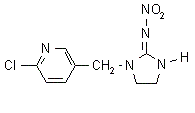Pesticides >> Insecticide >> Imidacloprid
Imidacloprid
Imidacloprid 95%TC
Imidacloprid 70%WDG
Imidacloprid 70%WP
Imidacloprid 70%WS
Imidacloprid 35%SC
Imidacloprid 20%SL
Insecticide
neonicotinoid

Imidacloprid NOMENCLATURE
Common name imidacloprid (BSI, draft E-ISO); imidaclopride ((m)
F-ISO)
IUPAC name 1-(6-chloro-3-pyridylmethyl)-N-nitroimidazolidin-2-ylideneamine
Chemical Abstracts name 1-[(6-chloro-3-pyridinyl)methyl]-N-nitro-2-imidazolidinimine
CAS RN [138261-41-3] Development codes BAY NTN 33 893 (Bayer)
Imidacloprid APPLICATIONS
Biochemistry Acts as an antagonist by binding to postsynaptic nicotinic
receptors in the insect central nervous system. Mode of action Systemic
insecticide with translaminar activity and with contact and stomach
action. Readily taken up by the plant and further distributed acropetally,
with good root-systemic action. Uses Control of sucking insects,
including rice-, leaf- and planthoppers, aphids, thrips and whitefly.
Also effective against soil insects, termites and some species of
biting insects, such as rice water weevil and Colorado beetle. Has
no effect on nematodes and spider mites. Used as a seed dressing,
as soil treatment and as foliar treatment in different crops, e.g.
rice, cotton, cereals, maize, sugar beet, potatoes, vegetables,
citrus fruit, pome fruit and stone fruit. Applied at 25-100 g/ha
for foliar application, and 50-175 g/100 kg seed for most seed treatments,
and 350-700 g/100 kg cotton seed. Also used to controls fleas in
dogs and cats. Formulation types DP; FS; GR; SC; SL; WG; WP; WS.
Imidacloprid ANALYSIS
Residues by hplc (F-J. Placke & E. Weber, Pflanzenschutz-Nachrich.
Bayer, 93/2, 46, 109-182 (1993)). A method has been developed based
on the presence of the 6-chloropyridinylmethylene moiety in all
known plant and animal metabolites.
Imidacloprid MAMMALIAN TOXICOLOGY
Oral Acute oral LD50 for male and female rats c. 450 mg/kg. Skin
and eye Acute percutaneous LD50 (24 h) for rats >5000 mg/kg.
Non-irritating to eyes and skin (rabbits). Not a skin sensitiser.
Inhalation LC50 (4 h) for rats >5323 mg/m3 dust, 69 mg/m3 air
(aerosol). NOEL (2 y) for male rats 100, female rats 300, mice 330
mg/kg diet; (52 w) for dogs 500 mg/kg diet. ADI 0.057 mg/kg b.w.
Other Not mutagenic or teratogenic. Toxicity class WHO (a.i.) II;
EPA (formulation) II
Imidacloprid ECOTOXICOLOGY
Birds Acute oral LD50 for Japanese quail 31, bobwhite quail 152
mg/kg. Dietary LC50 (5 d) for bobwhite quail 2225, mallard ducks
>5000 mg/kg. Fish LC50 (96 h) for golden orfe 237, rainbow trout
211 mg/l. Daphnia LC50 (48 h) 85 mg/l. Algae ErC50 for Pseudokirchneriella
subcapitata >100 mg/l. Bees Harmful to honeybees by direct contact,
but no problems expected when not sprayed into flowering crop or
when used as a seed treatment. Worms LC50 for Eisenia foetida 10.7
mg/kg dry soil.